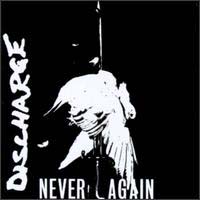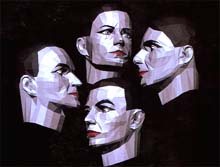Why metal is an ambient not discrete genre
People frequently ask "So what is an 'ambient metal' band? Have you actually seen one? Are there any metal bands out there who, if asked, would identify themselves as 'ambient metal'?" To understand why the term is used, it is important to examine first why bands do anything that they do and second, what the term "ambient" means in the context of history. Bands are assembled of individuals who together, in some form, decide what their output will be and create it. While much of this is a spontaneous project, there is behind-the-scenes transfer of information through shared musical influences or ideas and concepts the band members collectively find useful. It is unlikely that four guys with guitars sat down one day and said, "We should be the next cutting-edge thing. I know - let's do ambient music, but on guitars." A more realistic version is that a band formed and started playing with some ideas they found intellectually or musically stimulating.
Bands are assembled of individuals who together, in some form, decide what their output will be and create it. While much of this is a spontaneous project, there is behind-the-scenes transfer of information through shared musical influences or ideas and concepts the band members collectively find useful. It is unlikely that four guys with guitars sat down one day and said, "We should be the next cutting-edge thing. I know - let's do ambient music, but on guitars." A more realistic version is that a band formed and started playing with some ideas they found intellectually or musically stimulating.The earliest human music was strictly rhythmic; the next generation of change brought linear melodic music; the generation after that used harmony and syncopation to integrate the two, and this slowly gave way to the furthest evolution of form, in which melody as the primary content expression was given context by the most complex understanding of musical devices yet known. Despite its seemingly technical origins, this music achieved an acme of expressiveness in artistic outlook. Human culture is still waiting for another artistic movement with the patient spirit and yet unbridled passion of Beethoven, Bach, Strauss or Wagner.
In the media age of the 1950s-1960s, the previous popular forms of Christian hymns, blues, country and polka were whipped into a single entity and called "rock music." It has the populist features that classical music lacks: repetitive beat, droning pentatonic harmony, and constant dynamic intensity. It is cyclic music of an unchanging character. This linear constancy reflected the literature and ideals of the early industrial age, or modernism, although presented in a postmodern ("non-hierarchical") aesthetic concept, until punk music distilled rock music to a few chords and shattered the illusion of uniqueness to any given rock band.
We might call rock "discrete music" because it aimed at a simple, 1:1 ratio between simple and gesture in the music. While earlier music had used pentatonic scales, including accidental or "blue" notes, blues and rock standardized on the pentatonic scale plus a single blue note; most rock is major, harmonic minor, or blues scale composition because these allow a flexible harmony in which no notes are specific to major or minor keys, meaning they can be used over different tonal centers without any notes that sound bad against a chord. Rock standardized the song format on a simplified version of English sea ballads; rock standardized constant syncopated percussion; it also standardized topics and a role (sexual initiation of teenagers). It broke away from the classical idea of phrases which periodically harmonized to exclusively use chords -- descending from the guitar's role as a rhythm instrument in ensembles, minus the ensemble -- which caused rhythmic strumming within a narrow tonal range to replace the many notes and changing time signatures of what came to be called "lead rhythm" phrases. Borrowing from Anglo-Celtic, Scandinavian and German folk music, and adding a simplified version of the instrumentation used in German beerhouse bands, it took the lowest common denominator and made a fixed form of it. In short it was the perfect product, but in order to do that, it had to simplify itself into interchangeable parts which each had contextless and thus universal emotional symbolism.
 In the 1970s, a countermovement arose in which musicians began looking to new forms for inspiration, and found them in the neoclassical: a merging of classicalist ideas of melody and layered structure with the newfound populist beat patterns of reduced structural changes to prevent intrusion upon the actual song pattern established by melodic architecture. Kraftwerk, Tangerine Dream, and arguably the first ambient guitarist, Robert Fripp, embraced principles of this ethos contra the simplistic lifestyle support of mainstream rock. In this atmosphere underground metal was born with 1983 luminaries Slayer, Sodom and Bathory. Each put out an album colored by the dark careless phrasing of Venom and wrought in the tremolo strum and ambient offtime rhythmic structures of extreme hardcore. This heritage forms the basis of all underground metal.
In the 1970s, a countermovement arose in which musicians began looking to new forms for inspiration, and found them in the neoclassical: a merging of classicalist ideas of melody and layered structure with the newfound populist beat patterns of reduced structural changes to prevent intrusion upon the actual song pattern established by melodic architecture. Kraftwerk, Tangerine Dream, and arguably the first ambient guitarist, Robert Fripp, embraced principles of this ethos contra the simplistic lifestyle support of mainstream rock. In this atmosphere underground metal was born with 1983 luminaries Slayer, Sodom and Bathory. Each put out an album colored by the dark careless phrasing of Venom and wrought in the tremolo strum and ambient offtime rhythmic structures of extreme hardcore. This heritage forms the basis of all underground metal.The opposite of discrete music, but not yet approaching the complexity of classical, ambient music creates a harmonic texture and relegates percussion to a background role, letting the phrase lead the change of song structure, key and tempo. An ideal ambient composition takes unchanging rhythm and over it layers phrases, creating harmony from their conjoined effect in the way classical music does, making moods "ad hoc" relative to its starting point. Where discrete music focuses on each piece of a song being a thing unto itself, using a universal set of symbols, ambient music invents symbols specific to each song and as a result gives pieces of a song meaning only when existing in the context of others. In this, selected metal and synthesizer music (synthpop, electronica, ambient) are closer to their classical heritage than the distillation of popular memes that is rock. Not all metal and ambient music fits this description; many artists, figuring that their listening audience would rather have something immediately recognizable and familiar in a "new" form, use rock-styled composition with different instrumentation.
Good examples of ambient metal are found in At the Gates The Red in the Sky is Ours and Darkthrone Transilvanian Hunger most prominently, but these are the end product of an evolution that began when Black Sabbath began imitating the phrases of horror movie soundtracks in streams of power chords. The first three Morbid Angel albums, anything from Burzum, the first two Sepultura EPs, and Sarcófago I.N.R.I. all exhibit ambient tendencies, among many other albums. Not surprisingly, these bands tend to write about topics that are not "universal" in the sense of common to all human beings in the way morality is surmised to be absolute, but write from a perspective outside that of the human, as if showing us interactions of people and nature in a dispassionate, nihilistic universe which delights in conflict and interconnection more than symbols held up above nature itself.
As any change in musical style points to a change in thinking patterns, the rise of ambience in metal signifies a falling away from mainstream views -- which tend to be discrete, moralistic, utilitarian, and universalist -- toward a naturalistic and scientific view of reality. The linear is broken; the complex and multithreaded view of causality that ancient civilizations had, in which no single event led to change, but a collaboration of events, has been restored in the music itself, as has a belief in varied dynamics, implying a greater narrative range. In this light, it is impossible to see this music as anything but an ongoing revolution, even if the names used here are still foreign to most of the bands producing it.

No Responses to "Ambient Metal"
Posting Komentar